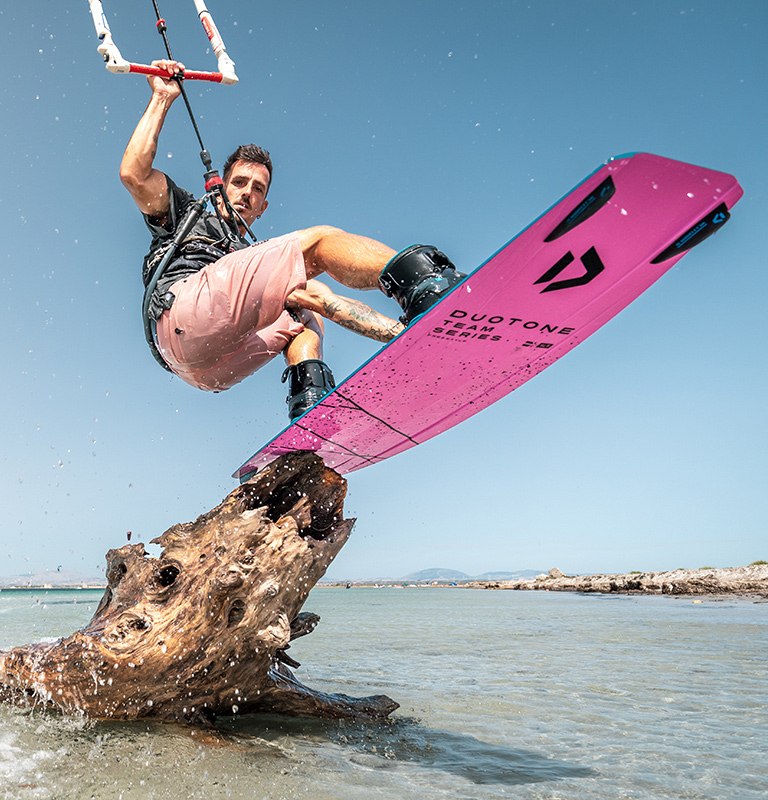At Mercy of the Wind: Snowkiting the Greenland Ice Cap

Win a €100 Voucher for Duotone Apparel this issue in our FREE subscriber prize draw.
Last May, polar guide and snowkite expert Carl Avery set off on an expedition like no other. Accompanied by two ambitious clients; a surgeon and a banker, they set off for one hell of an adventure – Snowkiting the Greenland Ice Cap.
The rotor blades made a familiar “whop-whop-whop” sound as the helicopter touched down on the dull grey frozen surface. Polar Guide Carl Alvey and his two clients bundled out as snow crystals filled the air, blasted into a frenzy by the downdraft. After hauling equipment from the belly of the aircraft, they crouched next to their sledges as it manoeuvred upward, away from their drop point near Narsaq, the most accessible southerly point of the Greenland Ice Cap.
The hulking sheet of ice smothers all but the fractured and mountainous coastline of the world’s largest island. Most of Greenland’s small population live along the western coastline, away from the barren interior which is largely the playground of curious adventurers. Less costly than the poles due to its greater accessibility, Greenland offers, “incredible opportunities to those who wish to test themselves with a long-distance expedition,” says Carl.
From Narsaq, Carl and his two clients Patrick, a surgeon from Luxembourg, and Chris, a banker from Australia, planned to ski 2,300km across the Ice Cap. They were headed to Qaanaaq, a lonely outpost in the Northwest and the home of the hardy indigenous people known as the Polar Eskimo. They set out for Qaanaaq in May 2019, without any outside support.
Polar travel is a game of patience. You pack a sledge full of supplies, strap on your skis and drive all your muscles forward to slide the dead weight along. You repeat that process day after day. A good skier might cover 40km in a day when the wind is low, and snow conditions are kind. A long road of toil though if you want to cover thousands of kilometres and haul along two hundred kilos of equipment and supplies. Few people ever travel such distances on skis alone.
The remedy to this backbreaking work is the wind. Harness its power using a snow kite, and you can be dragged over the snow-strewn surface at the speed of a car. Hundreds of kilometres can be skied in just one day. The flipside though is that it’s a damn sight harder to master than skiing, and the consequences of messing up could lead to an unwelcome and early trip home with broken bones. However, when it all comes together, “Its one of the purest ways to travel on an ice cap in a polar environment” says Carl, who is also an Ozone kites sponsored athlete.
On the Ice Cap, Carl and his clients kite-skied alongside each other, not straying too far ahead in case they lost sight of one another. Days were broken down into long kiting sessions of several hours with brief stops to rest and eat. This routine went on for 11 to 12 hours a day until the trio settled into their tent at night. Evenings were spent preparing dinner from packets of freeze-dried meals, making repairs, checking the next day’s weather and logging diary entries – the rhythm of life on a polar expedition.
Carl’s personal view on the kite gear:
“Over the past few years kite design as change at a great speed and on perverse trips I have been using the Chrono in its different versions, while the Chrono as been a great kite to ride on expeditions it has its drawbacks, in high wind, for example, it is challenging to land on your own, and on occasion not easy to handle on the ground. But this year was a game-changer with the development of the Chrono EXP, I was lucky to get my hands on one of the final prototypes this winter at my home in Haugastøl. With the new 5th line system, what a kite! just what I had been looking for; all the performance of the Chrono but now with Ozone’s 5th line safety system, Perfect!
My quiver for the expedition was an Edge 8m, 11m, and a 15m Chrono EXP with an 18m Chrono EXP as a back up for the team. The Clients chose to ride the Alpha in 8 – 12 mas it is just a little more forgiving for the less experienced. I choose to use tube kites on expeditions in the smaller sizes as in the past they have given greater safety, but with the introduction of the EXP I could now change out the edge 11 for Chrono EXP.
The most important part of our Greenland quiver is the line lengths, 85% of the time I am riding the Chrono on a 50m line set to get the most out of the kite, but also have a 25m line setup for when the wind increases, these variations means we can ride one kite though a great wind range and means we need to carry fewer kites equaling much appreciated less weight. For the tube kites, I use a 25m and 35m line set”
For more information on Ozone’s Chrono EXP, please click here.

Win a €100 Voucher for Duotone Apparel this issue in our FREE subscriber prize draw.









